
在 Windows 10 中,当您想要将分区专门格式化为 FAT32(例如,将在手机中使用的 SD 卡)时,右键单击磁盘并选择格式化,只有 NTFS 和 exFAT 会显示为可能的格式选项。
还有其他方法吗,最好不要安装额外的工具或启动到不同的模式来格式化为 FAT32?
答案1
尽管LPChip 的答案是“正确的”,并且在大多数情况下应该有效除非分区超过 32GB。我通常使用来自 ridgecrop 的一些第三方软件,它可以做同样的事情,但可以处理更大的分区。我使用过他们的命令行fat32格式化程序 广泛地在过去的几年里。
他们有GUI 工具它现在或多或少地实现了它所声称的功能。格式化速度非常快,而且我从未遇到过任何问题。
答案2
是的,最多 32GB,后来我才发现。
格式的 GUI 版本仅限于 NTFS 和 exFAT,可能是因为这是您在 Windows 上所需要的。
幸运的是,如果您format从命令提示符运行,您可以指定更多选项来格式化磁盘。
Format /?显示以下内容:
Formats a disk for use with Windows.
FORMAT volume [/FS:file-system] [/V:label] [/Q] [/L[:state]] [/A:size]
[/C] [/I:state] [/X] [/P:passes] [/S:state]
FORMAT volume [/V:label] [/Q] [/F:size] [/P:passes]
FORMAT volume [/V:label] [/Q] [/T:tracks /N:sectors] [/P:passes]
FORMAT volume [/V:label] [/Q] [/P:passes]
FORMAT volume [/Q]
volume Specifies the drive letter (followed by a colon),
mount point, or volume name.
/FS:filesystem Specifies the type of the file system (FAT, FAT32, exFAT,
NTFS, UDF, ReFS).
/V:label Specifies the volume label.
/Q Performs a quick format. Note that this switch overrides /P.
/C NTFS only: Files created on the new volume will be compressed
by default.
/X Forces the volume to dismount first if necessary. All opened
handles to the volume would no longer be valid.
/R:revision UDF only: Forces the format to a specific UDF version
(1.02, 1.50, 2.00, 2.01, 2.50). The default
revision is 2.01.
/D UDF 2.50 only: Metadata will be duplicated.
/L[:state] NTFS Only: Overrides the default size of file record.
By default, a non-tiered volume will be formatted with small
size file records and a tiered volume will be formatted with
large size file records. /L and /L:enable forces format to
use large size file records and /L:disable forces format to
use small size file records.
/A:size Overrides the default allocation unit size. Default settings
are strongly recommended for general use.
ReFS supports 64K.
NTFS supports 512, 1024, 2048, 4096, 8192, 16K, 32K, 64K.
FAT supports 512, 1024, 2048, 4096, 8192, 16K, 32K, 64K,
(128K, 256K for sector size > 512 bytes).
FAT32 supports 512, 1024, 2048, 4096, 8192, 16K, 32K, 64K,
(128K, 256K for sector size > 512 bytes).
exFAT supports 512, 1024, 2048, 4096, 8192, 16K, 32K, 64K,
128K, 256K, 512K, 1M, 2M, 4M, 8M, 16M, 32M.
Note that the FAT and FAT32 files systems impose the
following restrictions on the number of clusters on a volume:
FAT: Number of clusters <= 65526
FAT32: 65526 < Number of clusters < 4177918
Format will immediately stop processing if it decides that
the above requirements cannot be met using the specified
cluster size.
NTFS compression is not supported for allocation unit sizes
above 4096.
/F:size Specifies the size of the floppy disk to format (1.44)
/T:tracks Specifies the number of tracks per disk side.
/N:sectors Specifies the number of sectors per track.
/P:count Zero every sector on the volume. After that, the volume
will be overwritten "count" times using a different
random number each time. If "count" is zero, no additional
overwrites are made after zeroing every sector. This switch
is ignored when /Q is specified.
/S:state Specifies support for short filenames (enable, disable)
Short names are disabled by default
/I:state ReFS only: Specifies whether integrity should be enabled on
the new volume. "state" is either "enable" or "disable"
Integrity is enabled on storage that supports data redundancy
by default.
/DAX[:state] NTFS Only: Enable direct access storage (DAX) mode for this
volume. In DAX mode, the volume is accessed via the memory
bus, boosting IO performance. A volume can be formatted
with DAX mode only if the hardware is DAX capable.
State can specify "enable" or "disable". /DAX is considered
as /DAX:enable.
如您所见,/FS:filesystem允许您格式化为
FAT(fat16)、FAT32、exFAT、NTFS、UDF 和 ReFS。
答案3
我刚刚遇到了这个问题,发现 Windows 内置的磁盘管理工具可以处理以下分区4GB 或更少。
控制面板 > 系统和安全 > 管理工具 > 创建和格式化硬盘分区或搜索磁盘管理。
右键单击卷并选择收缩量...,然后将其缩小到 4GB 或更小。之后,FAT32和快速格式化选项将在格式...对话。
答案4
也许这是不寻常的方法,但作为YUMI 实用程序,我可以说它也可以格式化为FAT32,尽管这不是它的主要功能。
将任何 ISO 映像加载到 SD 卡时,您可以选择 Fat32 格式
非常适合大容量 SD 卡,我已经多次这样做了。
此工具已存档,因此链接可能很快就会失效。




